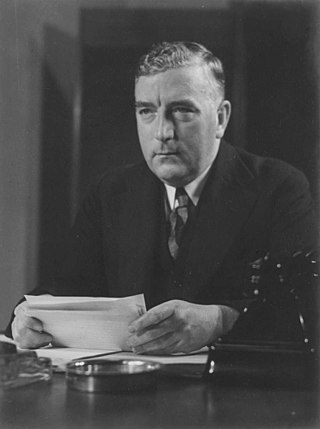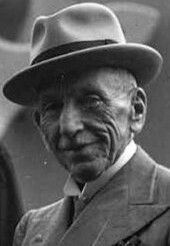
Sir Robert Gordon Menzies was an Australian politician and lawyer who served as the 12th prime minister of Australia from 1939 to 1941 and 1949 to 1966. He held office as the leader of the United Australia Party (UAP) in his first term, and subsequently as the inaugural leader of the Liberal Party of Australia, which he was responsible for establishing and defining in policy and political outreach. He is the longest-serving prime minister in Australian history.

The United Australia Party (UAP) was an Australian political party that was founded in 1931 and dissolved in 1945. The party won four federal elections in that time, usually governing in coalition with the Country Party. It provided two prime ministers: Joseph Lyons (1932–1939) and Robert Menzies (1939–1941).

John Curtin was an Australian politician who served as the 14th prime minister of Australia from 1941 until his death in 1945. He held office as the leader of the Australian Labor Party (ALP), having been most notable for leading the country through the majority of World War II, including all but the last few weeks of the war in the Pacific. Curtin's leadership skills and personal character were acclaimed by his political contemporaries and he is frequently ranked as one of Australia's greatest prime ministers and political leaders.

Francis Michael Forde was an Australian politician who served as the 15th prime minister of Australia from 6 to 13 July 1945, in a caretaker capacity following the death of John Curtin. He was deputy leader of the Australian Labor Party (ALP) from 1932 to 1946 and is the shortest-serving prime minister in Australia's history.

Sir Arthur William Fadden was an Australian politician and accountant who served as the 13th prime minister of Australia from 29 August to 7 October 1941. He was the leader of the Country Party from 1940 to 1958 and served as treasurer of Australia from 1940 to 1941 and 1949 to 1958.

Sir Paul Meernaa Caedwalla Hasluck, was an Australian statesman who served as the 17th Governor-General of Australia, in office from 1969 to 1974. Prior to that, he was a Liberal Party politician, holding ministerial office continuously from 1951 to 1969.

The ministerfor Defence, also known as the Defence minister, is the minister of state of the Commonwealth of Australia charged with overseeing the organisation, implementation, and formulation of strategic policy in defence and military matters as the head of the Department of Defence. The Defence minister directs the government’s approach to the Australian Defence Organisation and the Australian Defence Force. The current Defence minister is Richard Marles, who is concurrently serving as deputy prime minister of Australia, he was selected by Prime Minister Anthony Albanese in May 2022 following the 2022 Australian federal election.

South West Pacific Area (SWPA) was the name given to the Allied supreme military command in the South West Pacific Theatre of World War II. It was one of four major Allied commands in the Pacific War. SWPA included the Philippines, Borneo, the Dutch East Indies, East Timor, Australia, the Territories of Papua and New Guinea, and the western part of the Solomon Islands. It primarily consisted of United States and Australian forces, although Dutch, Filipino, British, and other Allied forces also served in the SWPA.

Edward John Ward was an Australian politician who represented the Australian Labor Party (ALP) in federal parliament for over 30 years. He was the member for East Sydney for all but six and a half weeks from 1931 until his death in 1963. He served as a minister in the Curtin and Chifley governments from 1941 to 1949, and was also known for his role in the ALP split of 1931.

In early 1942, elements of the Imperial Japanese Navy (IJN) proposed an invasion of mainland Australia. This proposal was opposed by the Imperial Japanese Army and Prime Minister Hideki Tojo, who regarded it as being unfeasible, given Australia's geography and the strength of the Allied defences. Instead, the Japanese military adopted a strategy of isolating mainland Australia from the United States by advancing through the South Pacific. This offensive was abandoned following the Battle of the Coral Sea and the Battle of Midway in May and June 1942, and all subsequent Japanese operations in the vicinity of Australia were undertaken to slow the advance of Allied forces.

The Defence Act 1943 (Cth) was an Act of the Parliament of Australia, which enabled the Militia, and thus conscripts, to serve overseas in the Pacific.

Australia entered World War II on 3 September 1939, following the government's acceptance of the United Kingdom's declaration of war on Nazi Germany. Australia later entered into a state of war with other members of the Axis powers, including the Kingdom of Italy on 11 June 1940, and the Empire of Japan on 9 December 1941. By the end of the war almost one million Australians had served in the armed forces, whose military units fought primarily in the European theatre, North African campaign, and the South West Pacific theatre. In addition, Australia came under direct attack for the first time in its post-colonial history. Its casualties from enemy action during the war were 27,073 killed and 23,477 wounded. Many more suffered from tropical disease, hunger, and harsh conditions in captivity; of the 21,467 Australian prisoners taken by the Japanese, only 14,000 survived.

Sir Eric John Harrison, was an Australian politician and diplomat. He was the inaugural deputy leader of the Liberal Party (1945–1956), and a government minister under four prime ministers. He was later High Commissioner to the United Kingdom from 1956 to 1964.

Although most Australian civilians lived far from the front line, the Australian home front during World War II played a significant role in the Allied victory and led to permanent changes to Australian society.

The Advisory War Council (AWC) was an Australian Government body during World War II. The AWC was established on 28 October 1940 to draw all the major political parties in the Parliament of Australia into the process of making decisions on Australia's war effort and was disbanded on 30 August 1945.

The Menzies government (1949–1966) refers to the second period of federal executive government of Australia led by Prime Minister Robert Menzies. It was made up of members of a Liberal–Country Party coalition in the Australian Parliament from 1949 to 1966. Menzies led the Liberal–Country Coalition to election victories in 1949, 1951, 1954, 1955, 1958, 1961 and 1963. Robert Menzies was Australia's longest serving prime minister. He had served a previous term as prime minister as leader of the United Australia Party from 1939 to 1941. Although he would retire in 1966, his party would remain in office until 1972, an unprecedented 23 years of government from nine consecutive election victories.

The Curtin government was the federal executive government of Australia led by Prime Minister John Curtin. It was made up of members of the Australian Labor Party in the Australian Parliament from 1941 to 1945.

The Menzies government (1939–1941) refers to the federal executive government of Australia led by Prime Minister Robert Menzies. Menzies led the United Australia Party in the Australian Parliament from 1939 to 1941. Menzies served a later and longer term as prime minister as leader of a successor party, the Liberal Party of Australia from 1949 to 1966.

The Fadden government was the federal executive government of Australia led by Prime Minister Arthur Fadden, as leader of the Country Party. He was appointed prime minister on 29 August 1941, during World War II, following the resignation of Robert Menzies of the United Australia Party (UAP). Fadden continued the coalition government between the Country Party and the UAP, but after just over one month in office the government was defeated on a confidence motion. Fadden was succeeded as prime minister on 7 October 1941 by John Curtin of the Australian Labor Party (ALP).

The United Australia Party (UAP) held a leadership election on 9 October 1941, following the resignation of Robert Menzies on the same day. Billy Hughes was elected as his replacement.
















